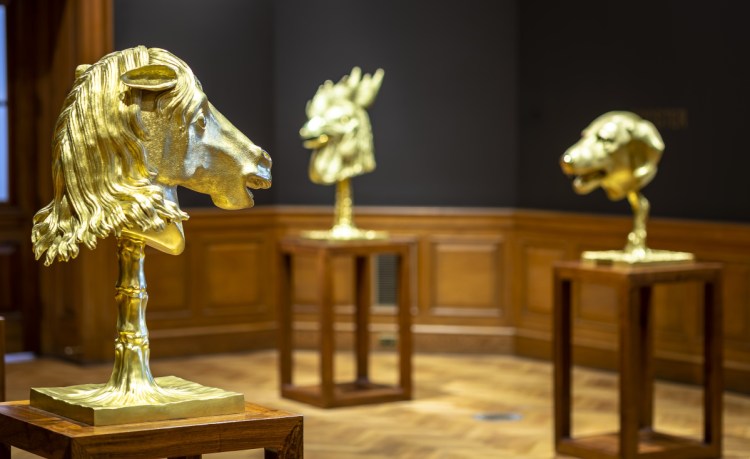ROCKLAND — Early this month, the Chinese government razed the Beijing studio of Ai Weiwei, taking down the walls with a backhoe and leaving his studio assistants scrambling to save his art. The destruction was brazen and bold, and not unprecedented. His Shanghai studio sustained a similar fate in 2011, and Ai has been imprisoned by Chinese authorities at least twice.
In Rockland, the first exhibition in Maine of work by the dissident artist continues through December. The Farnsworth Art Museum is showing Ai’s gilded “Circle of Animals/Zodiac Heads” in a stunningly beautiful and understated installation in the museum’s Rothschild Gallery. Ai created the dozen zodiac heads in 2011, drawing his inspiration from an ancient water-clock fountain of 12 bronze animal heads that represented the traditional Chinese zodiac. Ai made two versions, in gold and bronze, and sent them around the world for exhibition.
The gold zodiac heads finally made it to Maine.
Michael Komanecky, curator at the Farnsworth, said the installation has served as a teaching moment for visitors who were unfamiliar with Ai and his art. The recent destruction of the artist’s studio in Beijing drew worldwide attention and created urgent energy around the Farnsworth installation. “For visitors who are not familiar with Ai Weiwei’s work and activist activities, they’re discovering the work of one of the most important contemporary artists in the world for the first time,” Komanecky said. “The recent events in China are tragic. From many perspectives, it’s hard to imagine what led to the decision on the part of the authorities to do so, but from another perspective, it’s another episode in an ongoing internal debate over Ai Weiwei’s work and position both in the international art world and in China.”
Ai is as much an activist as he is an artist, and his activities have long garnered the attention of the Chinese authorities. He has been vocal in his criticism of the Chinese government, particularly on issues of human rights and democracy. His father, Ai Qing, was a poet, and the family was detained in a labor camp when Ai, now 61, was growing up. The family spent 16 years in the labor camp, returning to Beijing only after Mao’s death in 1976. He studied filmmaking in Beijing and moved to the United States in 1981. He lived in New York for a decade and returned to China in 1993 to help establish Beijing’s contemporary art scene.
His activism took on a sharper edge a decade ago, when he was tabbed to design a stadium for the Summer Olympics. That spring, an earthquake rattled a district in the Sichuan province, killing some 70,000 people. Many children died when their schools collapsed on top of them, the result, activists charged, of poor construction and substandard building materials.
Ai was incensed, and began accounting for the dead kids one by one, going to door to door himself and with a team of volunteers. They published the names of the dead children on a blog, leading to his confrontation with the government, which shut down his blog. He was beaten and placed under house arrest. In 2001, he was detained for 81 days on tax charges, just as his installation of bronze zodiac heads was opening to worldwide attention in New York.
In 2015, after the Chinese government restored his passport, he moved to Berlin, where he resides still.
Ai declined an interview request for this story but talked with National Public Radio this month about the destruction of his Beijing studio. “Compared to the memories which have been lost, compared to a society which has never established trust in the social order, a trust in the rule of law or a trust in any kind of unity in defending the rights of its people, what has been lost at my studio is insignificant, and I don’t even care,” he told NPR. “There are profoundly deeper and wider ruins in this deteriorating society where the human condition has been respected.”
The Farnsworth installation is dramatic and lively. The gold animal heads are placed on individual pedestals, two long rows of six facing one another. They are arranged so people can walk around them and observe them in detail or take in the long view of the dozen at once. Komanecky and his curatorial team have included long blocks of wall text to explain the context of the art and original garden on which Ai based his creations.
“It’s easy to appreciate the sculpture simply as objects that were fabricated by obviously very talented hands,” Komanecky said.
The original animal heads – an ox, rat, tiger, rabbit, dragon, snake, horse, ram, monkey, rooster, dog and boar – were created for a European-style garden that was part of the Yuanming Yuan, or the Old Summer Palace near Beijing. It was built over time, in the 1700s and 1800s, served as the residence of emperors and was considered an architectural wonder. The imperial retreat featured a European-style section with the zodiac water-clock fountain with animal heads marking the hours of the day.
The British and French destroyed the palace and gardens during the Opium War of 1860, and many pieces of art, including some of the zodiac heads, were stolen or destroyed. Seven survived, and in recent years, the seven have come to represent the achievements of the Qing dynasty, China’s humiliation by the West and a symbol of China’s long and complicated history. In his interpretation of the animal heads, Ai focuses on questions of looting and repatriation.
Staff Writer Bob Keyes can be contacted at 791-6457 or at:
bkeyes@pressherald.com
Twitter: pphbkeyes
Send questions/comments to the editors.



